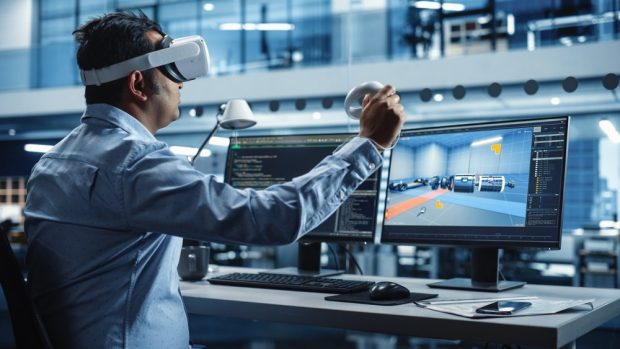Industrial Metaverses Are Useless Without IoT’s Real-Time Data

In the digital twin breweries Anheuser-Busch InBev is building in a private industrial metaverse, a sensor will tell the brewmaster if a vat of beer is fermenting properly, while the digital twin of Los Angeles’ SoFi Stadium uses footfall sensors to allow operations managers to see crowd flow in real time.
By providing a visual representation of the issue while letting operations managers or artificial intelligence (AI) fix them, and experiment with solutions to make things work more smoothly next time, the sensor networks at the heart of private corporate metaverses provide a real-time visual representation that many experts believe will make everything from factories and football stadiums to countrywide rail networks work better, faster and more efficiently.
In this fifth article in the PYMNTS industrial metaverse series about the fledgling use of private enterprise virtual realities, we’ll look at the vital role the internet of things (IoT) plays in creating these “digital twins” of factories, rail networks, space capsules and even cities.
See also: Nvidia, Deloitte Beat Meta to Punch With Enterprise VR Offering
Without a network of sensors using IoT technology to provide real-time data, metaverses would be little more than industrial versions of the game-style metaverse like Decentraland, Roblox and Meta’s Horizon Worlds, where people can wander around, see things, and socialize, Fujitsu Finland head of portfolio Esa Aho said in a July blog post.
“I wouldn’t be able to ‘operate’ anything because I am just looking at CAD images and cannot access or update the data,” he said. “Put a digital twin inside a metaverse and what we now have is a ‘metafactory,’ where people can experience and work with the machines and systems that comprise the factory.”
Working Together
It is the convergence of these two technologies, immersive virtual reality metaverses and rel-time data collected by IoT sensor networks, that allows people to “operate machinery, make consequence-free errors while experimenting with new settings, and learn from any aspect of a digital twin environment,” Aho said. “The opportunities are enormous and will change how we design, manufacture, sell, train, and deliver goods across supply chains.”
They also provide the artificial intelligences (AI) that are another key part of industrial metaverses to collect enough actual data to run simulations that can predict problems, improve workflow, and experiment with better way to do things.
Read more: Is the Industrial Metaverse Virtual Reality’s Commercial Future?
And, the larger and more complex the system, the more benefit it can get from digitally twinned industrial metaverse technology, according to IBM, which uses the technology in a number of business lines like enterprise asset management runs a Digital Twin Exchange as an industry resource.
“The object being studied — for example, a wind turbine — is outfitted with various sensors related to vital areas of functionality,” IBM said. “These sensors produce data about different aspects of the physical object’s performance, such as energy output, temperature, weather conditions and more.”
Using this data, the “virtual model can be used to run simulations, study performance issues and generate possible improvements, all with the goal of generating valuable insights — which can then be applied back to the original physical object,” it said.
Related: Linking Digital Twins to Make an Industrial Metaverse
Making Data Useful
However, there’s another side to the industrial metaverse-IoT collaboration, according to Nvidia, which is working with Siemens and Deliotte, among others, to build out industrial metaverses for the likes of BMW, Deutsche Rail and Anheuser-Busch InBev on its Omniverse industrial metaverse platform.
Specifically, it makes the data collected by IoT networks much easier to visualize and put to good use.
“Without a digital-twin approach, the interaction between radio transmitters, the environment, and humans and devices that are on the move had to be understood with less detail,” it said in a blog about the way mobile provider Ericsson is using the twin technologies to build out digital twins of cities to help it do a better job locating 5G antennas.
Before this, “many features had to be field tested only after the networks were already built,” Nvidia said.
Read also: Interpol Now Trains Crimefighters in the Industrial Metaverse
“If I look at 2,000 energy usage data points, it’s ridiculously hard to pick our trends and ‘tune’ such a system,” said John Burton, CEO & co-founder of digital twin developer UrsaLeo told IIoT World in August. “Adding visualizations can solve this problem – think of looking at a pointillistic painting, examining it dot by dot reveals nothing but stand back and the image becomes obvious.”
Not that IoT doesn’t have uses in entertainment and social-focused metaverses, too.
The ability to take real-world data and translate into the virtual world is “one of the darkest challenges hovering over the Metaverse sphere,” the Blockchain Council argued in September.
See more: German Railway Bets Industrial Metaverse Will Cut Delays and Boost Safety
“To derive the desired outcomes, it is essential that the data mapped from the real environment is accurate, planned, secured, relevant, and in real-time,” it said. “As IoT is already into the business for many years now with thousands of cameras, sensors, and tech devices in its cluster, it is quite an opportunity of exposure for the Metaverse.”
